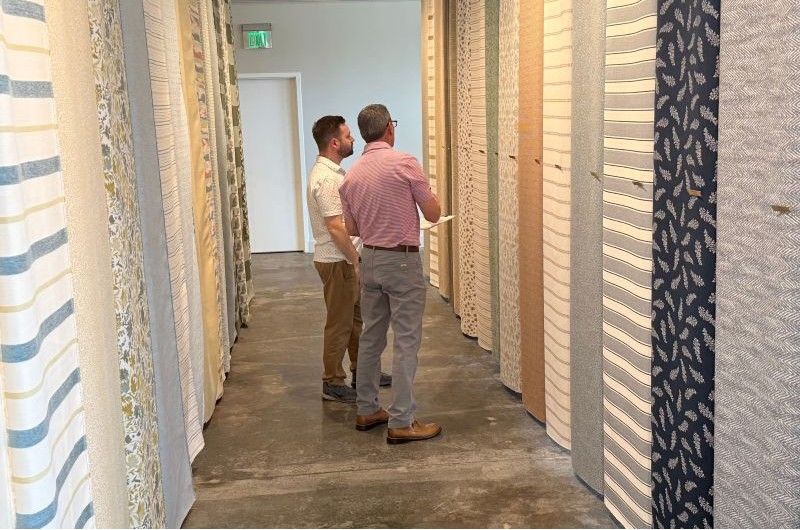Supply chain diversity, domestic sourcing capabilities drew interest from those manufacturers and retailers seeking high value fabrics for their upholstery lines
HIGH POINT — Unknowns regarding tariffs combined with a still-soft retail environment created a sense of caution among buyers attending the spring edition of the Interwoven fabric show held here this week.
Yet there also was a heightened sense of competition among fabric resources — importers and domestic manufacturers alike — looking to position themselves as the best value to those skittish buyers once the tariffs are finalized in the coming weeks and months.
As always, the event featured an abundance of new patterns, colors and textures across the fabric spectrum. Leather resources also showed a wide mix of hides in new finishes and textures, with plenty of color also splashed across the mix.
And while some said the three-day event was more lightly attended than normal following the spring High Point Market just a few short weeks ago, not everyone reported soft buyer attendance. Some said the event drew plenty of manufacturers and retailers alike looking to brighten their product assortment and floors with the latest styles.
For many, the event was an opportunity to get early orders in for fabric swatches to begin planning for new product for the fall High Point Market cycle or even the fall shopping season at retail. Others still sought to order existing patterns from tariff-free inventory, including fabrics on items shown at the April market.
Of course, China tariffs were a hot topic of conversation, having come down from the dizzying heights of 145% to 30% earlier this month. That not only has led customers to reinstate orders they had on hold, but also to take a closer look at the large number of offerings from China being shown here this week.
For those showing China product, much of the tariffs have been built into the pricing of new product with the assumption that the final rate may not shift too much lower or higher than the current 30%.
For example, J. Allen Fabric continues to import 100% of its fabric mix from China and said it never stopped flowing goods from China even with the 145% rate. Thus, it continues to maintain a strong inventory position in its Los Angeles area warehouse.
And while instituting a graduated surcharge that never exceeded 30% to recoup some of the costs, it lowered this to an overall 20% price increase when the rate dropped to 30%.
Thus, with the increase built in, its product offerings this market ranged from about $3.95 per yard on chenille performance fabrics to new jacquard fabrics in the $10 to $11 range.
Bella Home showcased a wide mix of new fabrics from China priced from about $6 to about $14 per yard including a portion of the reduced China tariff.
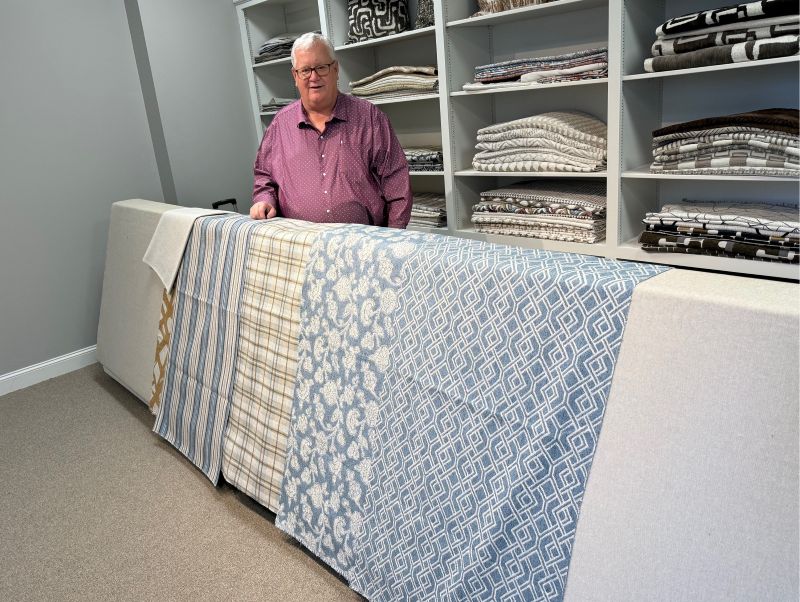
“We have new product, but the big word that everybody is talking about is tariffs,” said Ed Jacobs, a North Carolina-based sales representative for the company. “Even as it’s gone back and settled, customers are still asking questions. They are just digesting the new pricing.”
It also has inventory, which Jacobs said remains an important part of the business, particularly for key customers. Here, too, customers remain even more focused than ever on what the goods will cost.
“For the inventory I’ve had, they are still looking for it at a price,” he said, adding that customers still “have been about as understanding as they can. But I don’t know anybody that knows exactly what to do.”
A solution for many has been to shift sourcing to other countries to help diversify their product mix and minimize the tariff impact as much as possible. A key example of this is Z-Wovens, which maintains its main factory in China, but has since expanded to Vietnam with a plant whose first phase opened last August, with the second phase expected to open next month. By year end, the Vietnam production facilities will produce about 1 million yards a month of fabric compared with 3 million in China.
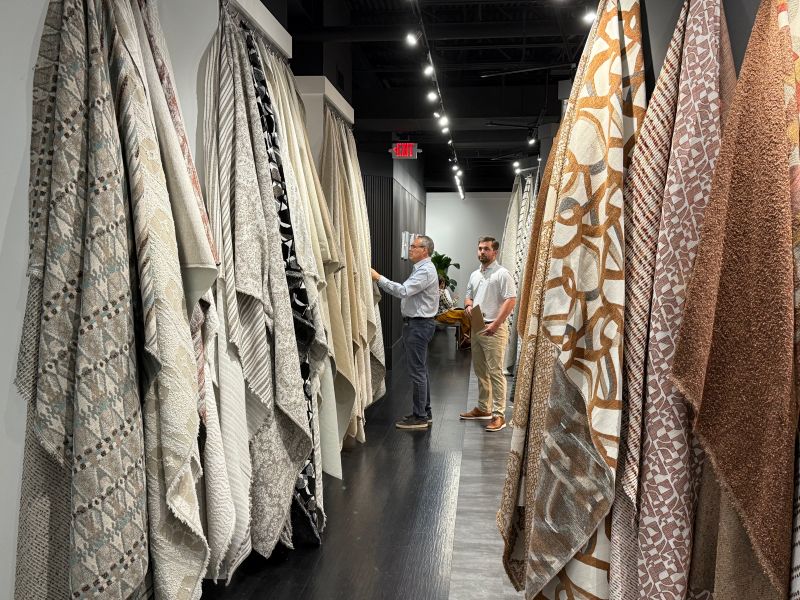
While orders were on hold at the China facility when tariffs were as high as 145%, they resumed once it went down to 30%.
Thus its mix at Interwoven included 50 new collections, all of which are produced in China. Many of these, however, also can be produced in Vietnam, where they are priced from $3.50 to $14 to $15 per yard. It also launched seven new collections in its Sunbelievable Solutions Dyed Polyester product line.
Chip Finneran, vice president of sales, said that while buyers’ attitudes were somewhat cautious regarding business in general, they responded very well to the product mix.
“People are positive, but with all the unknowns, they are hesitant,” he said.
Other companies also touted the diversity of their mix from a sourcing standpoint.
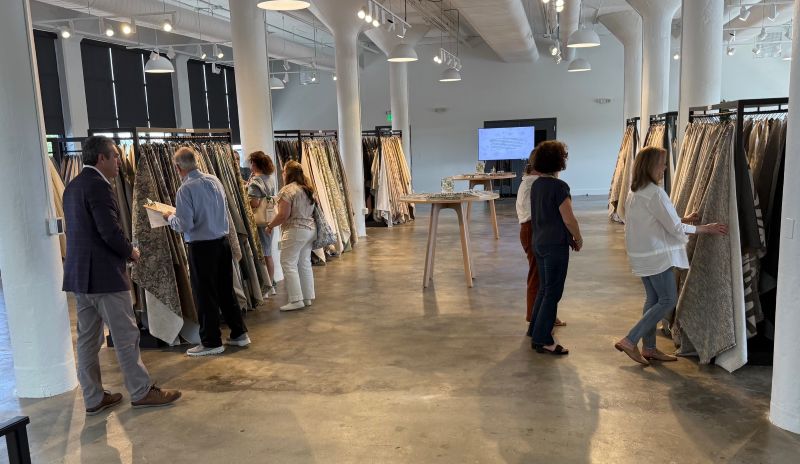
Culp sources much of its upholstery fabrics in China, but is further expanding its diversified global footprint to other countries including Vietnam and Turkey, for example. Its mix of new product shown here this week included as many as 40 new patterns from China and Vietnam.

“China in our view for the breadth of product for upholstery is where people have operated for decades,” said Iv Culp, president and chief executive officer. But he added that “We are working to bring other alternatives to market. It just takes time. But I believe we are uniquely positioned with a multi-tier, multi-country supply chain. Our eggs are not in one basket.”
Of the tariff situation in general, he added, “I think we understand that tariffs are part of our future, but we need tariffs to be in a range that allows business to transact. While we hope there is more movement, we are pleased where it is now because at least we have options.”
Interest in domestic product was also considerable, not only because of its perceived quality, but also because of its tariff-free status, with the exception of some yarns made overseas, including China.
Crypton showcased a mix of several new performance fabric patterns from an international sourcing network that includes Vietnam, India, Turkey and Taiwan.

But, responding to demand for U.S.-made product in the marketplace, the vast majority of its introductions were from its domestic production facilities, including some 30 to 40 new patterns available in a U.S.-made line priced from about $10 to $20 a yard.
Other companies also touted their domestic production capabilities including Valdese Weavers and Sunbrella along with STI and sister fabric resource Brentwood Textiles.
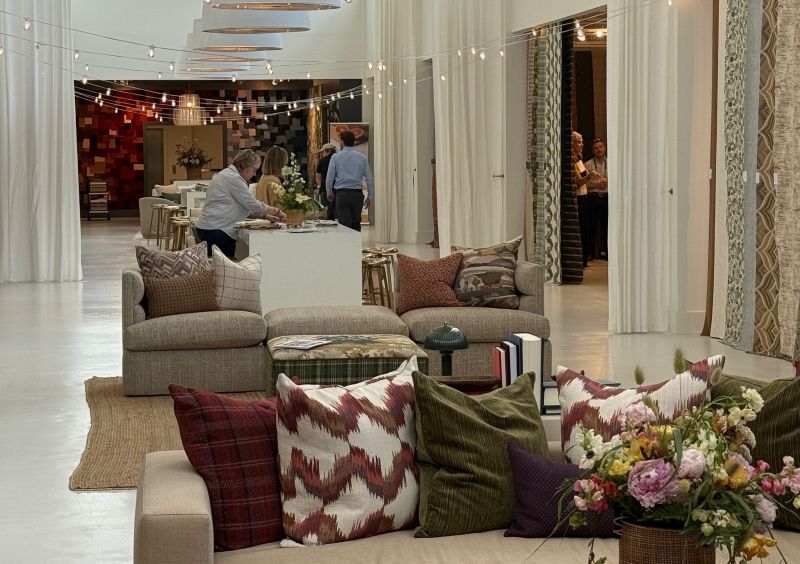
STI alone featured 91 new patterns this week, all of which are performance fabrics offered under the Revolution brand.
Topping out at around $9.95 per yard for its base cloths, some 75% of the mix was priced under $6 per yard, officials told Home News Now.
Achieving that type of price and value proposition in a performance fabric has been a work in progress, said Sean Gibbons, chief executive officer.
“We have just done a tremendous amount of work these last two years since Covid working with new, softer, high-value yarns that really are fully getting into our line now during this time of opportunity,” he said. “It’s not an environment where you can just sell anything because it’s domestic. It has to be the right product. We tend to focus on textures below $6, and we don’t have a lot of company in that niche.”
Overall, the company said it was very pleased with traffic and interest in the new line, which also included some 30 new patterns at Brentwood.

Sunbrella also featured a mix of new fabrics mostly produced in its domestic facilities in North and South Carolina, including its flagship 1.5 million-square-foot plant in Anderson, South Carolina.
Suzanne Roberts, vice president and general manager of Sunbrella, described traffic at the event as fantastic, which she attributed partly to the interest in domestic product.
“We will be where our customers need us and right now a lot of people need U.S. product. We are well positioned right now to answer that.
“What we try to do is partner with our customers and answer their needs regardless of what it is,” she added. “We are all about partnership.”
